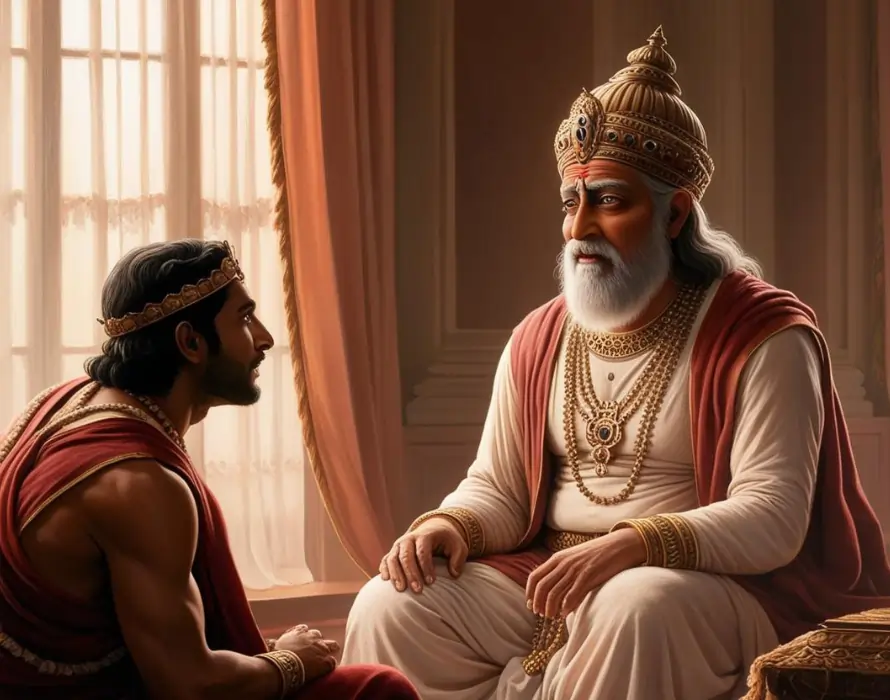The Bhagavad Gita begins with a powerful scene—a battlefield charged with tension, where warriors stand ready to fight a great war. It is here that we meet Arjuna, a hero consumed by doubt, fear, and moral confusion.
Chapter One, Arjuna Vishada Yoga (The Yoga of Arjuna’s Dejection), is not just about war but about the struggles we all face when life feels overwhelming.
For children, this chapter can be a starting point to explore concepts of courage, responsibility, and decision-making.
In this article, we will focus on Gita Chapter One, Sholka One’s teachings, and discuss how to introduce these profound lessons in a way kids can understand and relate to.
If you want to read how to teach the entire Gita, read this article.
Original Sanskrit Sloka with Simple Explanations for Kids
1. Dhritarashtra’s Curiosity (Sloka 1.1)
Sanskrit:
धृतराष्ट्र उवाच |
धर्मक्षेत्रे कुरुक्षेत्रे समवेता युयुत्सवः |
मामकाः पाण्डवाश्चैव किमकुर्वत सञ्जय ||1||
English:
dhṛitarāśhtra uvācha
dharma-kṣhetre kuru-kṣhetre samavetā yuyutsavaḥ
māmakāḥ pāṇḍavāśhchaiva kimakurvata sañjaya
Shloka Meaning:
First line
धृतराष्ट्र उवाच (dhṛitarāśhtraḥ uvācha)—Dhritarashtra said;
Second line
धर्मक्षेत्रे (dharma-kṣhetre)—in the land of dharma;
कुरुक्षेत्रे (kuru-kṣhetre)—at Kurukshetra;
समवेता (samavetā)—having gathered;
युयुत्सवः (yuyutsavaḥ)—desiring to fight;
Third line
मामकाः (māmakāḥ)—my sons;
पाण्डवाश्चैव (pāṇḍavāḥ)—and the sons of Pandu;
किमकुर्वत (kimakurvata)—what did they do;
सञ्जय (sañjaya)—Sanjay
Complete English Translation
Dhritarashtra said: In the land of Dharma, at Kurukshetra, my sons and the sons of Pandu have gathered. They are desiring to fight. Sanjay, tell me, what are they doing?
Points to discuss with children
The Importance of Curiosity and the Power of Asking Questions
Although Dhritarashtra cannot see what’s happening, he still asks Sanjay for an update. This simple act opens up an opportunity to talk to our kids about curiosity and why asking questions is so important.
Attachment, Bias, and Value
In the shloka, Dhritarashtra refers to his sons as “my sons” and his nephews as “sons of Pandu.” With older kids, this can lead to a thought-provoking discussion about how language often reveals unconscious biases. It’s also a chance to explore how we attribute value to people and things based on whether we see them as “ours.” Just as Dhritarashtra distances himself from his nephews, we can encourage teens to reflect on how attachment shapes their perception of others.
Fun age-appropriate activities to help your child understand the concepts mentioned in the Shloka
For Ages 3-5: Building Curiosity and Early Understanding
Activities:
- Ask Me Anything Game: Encourage kids to ask as many questions as they can about a topic they’re curious about. Provide simple, engaging answers.
- Role Play: Use puppets to act out a scene where one character asks questions to learn something new. Let the child guide the story.
- Sorting Game: Present objects (e.g., toys, blocks) and ask kids to sort them into “mine” and “not mine.” Discuss how both groups are equally fun or valuable.
Questions to Discuss:
- “What’s something you want to know about the world?”
- “Would you be less careful or more careful while playing with a toy that belongs to someone else? Why?”
For Ages 6-9: Developing Self-Awareness and Understanding Bias
Activities:
- Curiosity Jar: Write questions on slips of paper (e.g., “Why is the sky blue?” “How do birds fly?”) and take turns answering or researching them.
- Family Tree Activity: Explore how family members are connected and discuss how we sometimes feel closer to people in our immediate family.
Questions to Spark Insight:
- “Why do you think Dhritarashtra wanted to know what was happening in real-time?”
- “How do you feel when you share your favorite thing compared to something you don’t like as much?”
For Ages 10-12: Reflecting on Language and Values
Activities:
- Bias in Action: Use examples from TV shows or books to point out language that reflects bias (e.g., “Why is one group called ‘heroes’ while another is called ‘villains’?”).
- Value Web: Create a web showing how people and things in their lives are connected, discussing why some are considered “closer” than others.
Questions to Spark Insight:
- “Do you think the way Dhritarashtra speaks about his nephews is fair? Why or why not?”
- “Have you ever felt like someone valued their own things more than yours? How did that feel?”
For Ages 13-15: Discussing Unconscious Bias and Complex Relationships
Activities:
- Debate Club: Host a debate on topics like “Is curiosity more important than knowledge?”
- Media Critique: Analyze a movie or ad for bias in how characters or groups are presented.
Questions to Spark Insight:
- “How does language shape the way we think about others?”
- “What biases do you think Dhritarashtra shows? Do you think we all have similar biases?”
For Ages 16-18: Diving Deep into Philosophy and Ethics
Activities:
- Philosophical Discussion Circles: Discuss how attachment and bias impact ethical decisions using examples from real life or history.
- Creative Writing: Write a short story from Dhritarashtra’s perspective, exploring his thoughts and feelings about the war.
Questions to Spark Insight:
- “Is it possible to completely avoid bias? Should we?”
- “Does asking questions always lead to better decisions? Why or why not?”
Final Thoughts: Lessons for Life from Chapter One
Through storytelling, creative activities, and thoughtful discussions, we can show kids that the Bhagavad Gita isn’t just an ancient text—it’s a guidebook for handling life’s challenges with wisdom and grace.



2 responses to “Gita Chapter One Shloka One for Kids: Facing Doubts with Wisdom and Courage”
[…] Chapter 1, Shloka 1, we learned that Dhritarashtra asked Sanjay to tell him what was happening. In this […]
[…] Shloka One: Dhritarashtra’s Curiosity (Tips to teach this Shloka’s meaning). […]